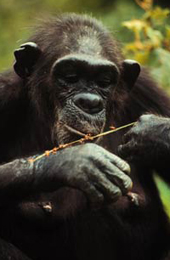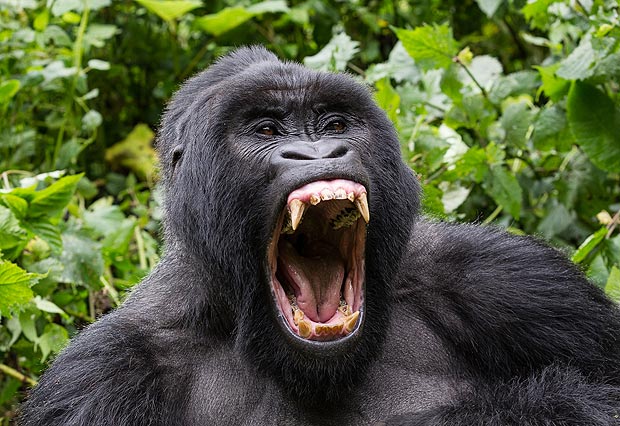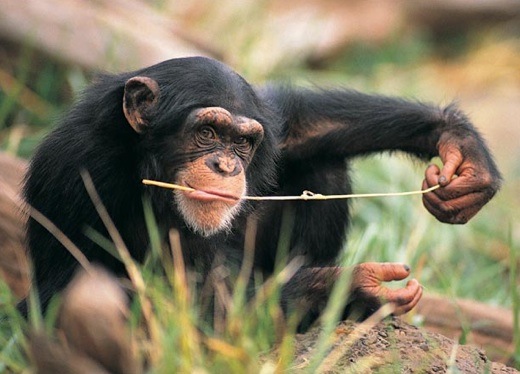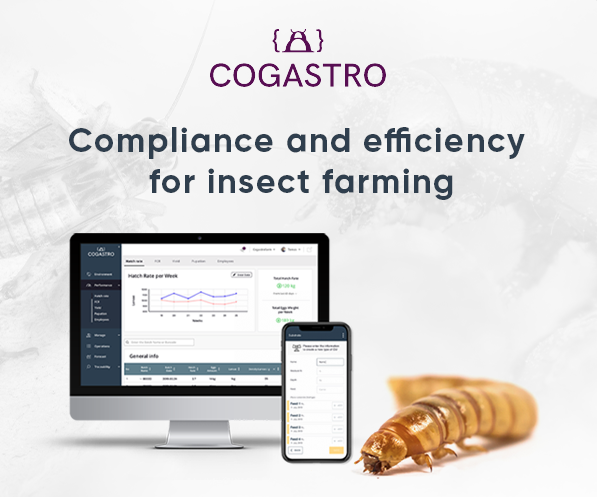There’s a well-known fact that scientists often observe in our closest genetic relatives in the animal kingdom, but something most people choose to ignore: chimpanzees eating insects!
They’re actually quite adept fisher-apes, using long sticks to poke into termite mounds to extract the bugs and eat them (among other ways of finding them). In fact, it’s one of the chimpanzee’s most common usages for tools – foraging for edible insects.

Flo the chimpanzee eating insects – termites, specifically
But wait, you’re saying, I thought chimpanzees, like all other apes, only ate plants and fruit? And for sure gorillas are vegan, because my favorite vegan website sells t-shirts for plant-based athletes touting the raw, plant-based diet of gorillas as similar to us vegans! Don’t start saying they eat bugs just because Jane Goodall witnessed a gorilla eat a bug one time…
Nope, I wouldn’t do that. The reality is that it’s common knowledge in the scientific community that chimps, gorillas, and other apes eat insects regularly as part of their diet.
However, because they’re “eating bugs”, which in the western world is still looked at mostly with disgust (although that’s finally changing!), nearly everyone just dismisses it as a weird thing apes do sometimes that isn’t really part of their diet.
But it definitely is – and it’s an important part of their nutritional intake, too, it turns out. Here’s a quick video to see for yourself how they fish for termites, before looking at the facts of insects in the chimpanzee diet.
First of all, is this legitimately part of the chimpanzee “diet”, or is termite fishing an isolated occurrence for other reasons? Yep, according to most research, it’s legit a thing with chimps.
And by no means is insect consumption an isolated occurrence among just some chimp populations. With very few exceptions, termites and/or ants are eaten about half the days out of a year on average, and during peak seasons are an almost daily item, constituting a significant staple food in the diet (in terms of regularity), the remains of which show up in a minimum of approximately 25% of all chimpanzee stool samples.[1][2]
Ok, fine, you might say, so there are bugs in their poop, that doesn’t actually mean that they meant to eat them. Just like the USDA allows commercial farmers to get some bugs in with the veggies they’re harvesting[3][4] (which a vegan might inadvertently eat, this probably just means there are insects in the plants and fruits the chimps are eating! Right?
The author of the above quote goes on to explain:
the bulk of chimpanzees’ animal food consumption actually comes in the form of social insects[5] (termites, ants, and bees), which constitute a much higher payoff for the labor invested to obtain them[6] than catching the colobus monkeys that are often the featured flesh item for chimps.
Wait, what? Chimps eat other monkeys?! Apparently, yes, but I’m going to leave that alone (feel free to research it yourself) and just focus on a more common and important part of their diet: insect nutrition.

Chimpanzees using a stick as a tool to fish for termites, which constitute a small but consistent percentage of their diet.
Chimps do get the majority of their nutrition from fruits and plants, but the percentage that they obtain from eating insects is still significant. In fact, while some insects are only eaten seasonally, during insect peak season chimps eat bugs on a near-daily basis. On average, termites and/or ants are eaten about half the year.[7]
And while insects may only make up between 5-8% of the chimpanzee diet, they spend as much as 17% of their feeding time[8] on fishing for, collecting, and eating bugs.
Another interesting item that chimpanzees eat – which may be the most prized food item of all – is honey[9], which they get directly from the bee hives. While that might not be surprising – who doesn’t like honey! – what is surprising is that the chimpanzees eat the bees and larvae which are still embedded in the honeycomb.
As anyone who has studied entomophagy will tell you, bee larvae is among the most nutritious insect food available. No wonder chimps love it so much!
But if insects make up a small percentage of the chimpanzee diet, is it really significant enough to actually matter? Well, those who have studied the issue in-depth say yes.
Thus, even given the largely frugivorous component of their diets, it would be erroneous to infer..that the 5% to possibly 8% or so of their diet that is animal foods (not to mention other foods) is insignificant, or could be thrown out or disregarded without consequence–
the extreme variety in their diet being one of its defining features. Remember that health is dependent on getting not just the right amounts of macro-
elements such as carbohydrates, fats, and proteins, but also critical amounts of trace minerals and vitamins…We require, and are evolutionarily adapted to, the behavior that is natural to us. Where chimps are concerned, 5% or 8% animal food–
whatever it actually is– is a modest but significant amount, and not something you can just say is incidental or could be thrown out without materially changing the facts.[10]
Ok, you say, but that’s the chimpanzee. Nobody is making shirts saying chimps are vegans. But Gorillas are the strongest apes, and they’re vegans, all their strength is 100% plant-based. Right?
Actually, no – and that’s the interesting thing. ALL apes have been observed to eat insects[11], which would make them entovegan. And a few types of apes also eat eggs, which would make them entotarian. The apes who eat the least insects are gorillas, but, check this out!
A study in Cameroon by Isra Deblauwe showed that gorillas have a high frequency of insect-eating and a high prey diversity, even higher than those for the sympatric chimpanzees. There are important differences in the nutritional composition of the gorilla and chimpanzee termite prey species.
Gorillas select termites high in iron and ash with possible anti-diarrhoeal characteristics. Termite eating in western lowland gorillas might therefore be a high quality alternative for geophagy.
Gorillas eat different insect species in different regions; there may even be traditions in prey choice.[12]
Clearly, even the “vegan” gorillas know that they should be supplementing that vegan diet with entomophagy – edible insects!
Then there’s the “vegan” apes who hunt and eat other monkeys – they would be, to steal the words of one sarcastic commenter on facebook making fun of this site, “carnovegan“. :-p

“Thanks for the honey-covered termites and bee larvae, sweety!”
So what’s the takeaway? Well, I think it’s fascinating to find that insects make up a significant part of the chimpanzee diet, and even the diets of other apes who most people consider to be fully vegan. They’ve evolved to eat what meets their nutritional needs.
This isn’t just random occurrences of apes eating bugs because there was nothing else to eat, either – these are chimpanzees, among the smartest animals, using tools to consistently dig out insects and eat them as part of their diet.
They forage and hunt for bugs, bees, and larvae, because they instinctively know they’re nutritious (and probably because they find them tasty as well).
Ultimately what I’ve learned is that apes are actually entovegan or entotarian…so I think it’s time to make some t-shirts and spread the message: chimpanzees get their smarts from insect nutrition!
#ChimpsEatBugs
Sources:
[1] Nicholson, Correcting the vegetarian myths about ape diets http://www.beyondveg.com/nicholson-w/hb/hb-interview1e.shtml
[2] McGrew, W.C. (1992) Chimpanzee Material Culture: Implications for Human Evolution. Cambridge, England: Cambridge University Press.
[3] https://www.huffingtonpost.ca/2012/05/02/bugs-in-food_n_1467694.html
[4] USDA Foreign Material Manual https://www.ams.usda.gov/sites/default/files/media/Foreign_Material_Manual%5B1%5D.pdf
[5] Tutin 1992, pp. 20-21; Tutin, Caroline E.G.; Fernandez, Michel; Rogers, M. Elizabeth; Williamson, Elizabeth A.; McGrew, William C. (1992) “Foraging profiles of sympatric lowland gorillas and chimpanzees in the Lopé Reserve, Gabon.” In: Whiten A. and Widdowson E.M. (editors/organizers), Foraging Strategies and Natural Diet of Monkeys, Apes, and Humans: Proceedings of a Royal Society Discussion Meeting held on 30 and 31 May, 1991. Oxford, England: Clarendon Press. (pp. 19-26); McGrew 1992, pp. 153-154.
[6] McGrew 1992, p. 154.
[7] McGrew 1992, p. 154.
[8] Goodall 1986, p. 233 (chart). The Chimpanzees of Gombe: Patterns of Behavior. Cambridge, Mass.; London, England: The Belknap Press of Harvard Univ. Press.
[9] McGrew 1992, p. 145.
[10] Nicholson, Humanity’s Evolutionary Prehistoric Diet and Ape Diets–continued, Part E
[11] McGrew 1992, p. 44 (chart), 54 and following.
[12] https://www.researchgate.net/publication/224934811_Insectivory_by_Gorilla_gorilla_gorilla_in_Southeast_Cameroon
Also thanks to Julie Lesnik for her eye-opening presentation at Eating Insects Athens which got me thinking about this.
Julie J Lesnik, Edible Insects and Human Evolution. University Press of Florida.
http://upf.com/book.asp?id=9780813056999

“Who ate all my insects?!”




